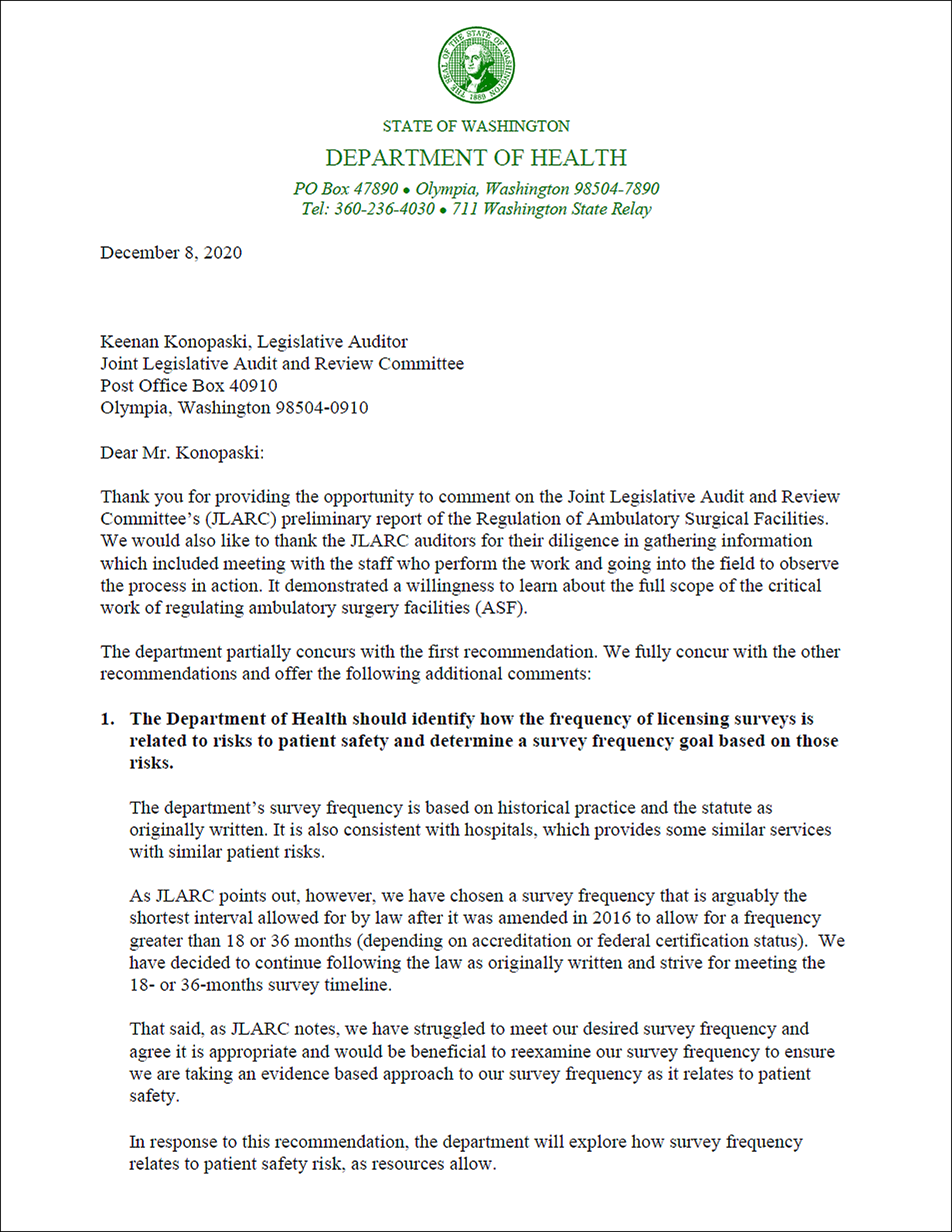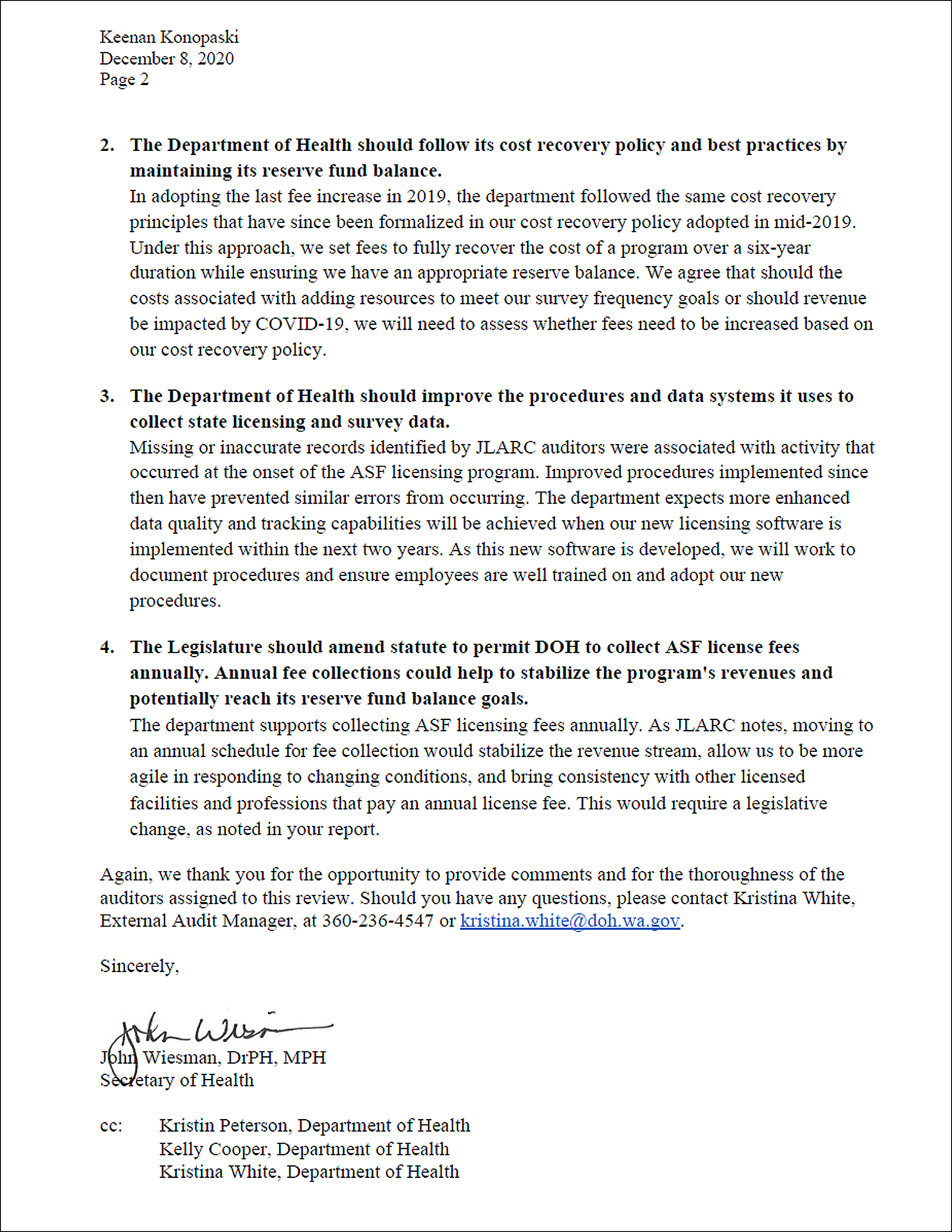The Legislature directed JLARC to review DOH oversight of ambulatory surgical facilities
In 2019, the Legislature directed JLARC to review the Department of Health's (DOH) oversight of ambulatory surgical facilities (ASFs). ASFs are medical facilities whose primary purpose is to provide outpatient surgical services, such as general surgery, orthopaedics, plastic surgery, endoscopy, eye surgery, and others.
DOH administers a state licensing and a federal certification program for ambulatory surgery in Washington
- State licensing program: DOH establishes health and safety standards for ASFs and surveys (inspects) the facilities to determine whether they meet state regulations. As of 2019, 186 ASFs held licenses in Washington. Facilities pay a license fee every three years to cover the cost of oversight, including surveys, credentialing, and all other program activities.
- Federal certification program: Through an agreement with the federal Centers for Medicare and Medicaid Services (CMS), DOH surveys facilities that receive Medicare and Medicaid payments for eligible patients. DOH evaluates whether these facilities meet the federal standards for CMS certification. This program is funded by a federal grant to DOH.
State and federal surveys are similar in scope and process, and DOH is making efforts to reduce survey time
JLARC staff found the two survey programs to be similar in scope, process, and level of effort required, even though they evaluate different sets of regulations. Some facilities receive both a state licensing survey and a federal certification survey.
The length of time it takes DOH to conduct surveys is consistent with other states. DOH is taking steps to reduce survey time, including focusing surveys on past non-compliance issues, coordinating multiple visits to reduce travel time, and relocating staff closer to the facilities they survey. Although these efforts are underway, they are not yet fully implemented and their impact on survey length is not yet known.
DOH has not met its state licensing survey frequency goal nor demonstrated how its goal impacts patient safety
Although DOH is meeting the federal priorities for certification surveys, it is not meeting its own goals for the state licensing program.
DOH aims to perform state licensing surveys of ASFs every 18 months if they are state-licensed only, or every 36 months if the facilities are also CMS-certified or accredited by an approved accreditation organization. DOH has not met this goal since it began to perform ASF state licensing surveys. As a result, DOH is more than a year behind schedule in surveying 71 percent of ASFs.
DOH has latitude in setting its survey frequency goal as long as it does not survey more frequently than allowed by state law. The department has not demonstrated that its current survey frequency goal is optimal for protecting patient safety. It could meet a less frequent survey goal within current resources.
Anticipated program costs for state licensing surveys exceed license fee revenue
DOH is required to fully fund its state licensing survey program from its license fees. To perform more surveys, DOH increased ASF license fees in 2019. However, the inspection staffing level funded with the additional revenue is not sufficient to meet the department's survey frequency goal and reduce the survey backlog.
To increase its survey capacity, DOH intends to increase inspection staff above the level assumed when setting fees. The cost of additional staff puts DOH at risk of a revenue shortfall that could not be covered by its existing fund balance on an ongoing basis. Without making changes to offset these additional costs, the program could be out of compliance in the future with state law and its own policy for maintaining a reserve fund to cover three months of operating expenses.
Data quality improvements could help DOH prioritize its state licensing surveys
JLARC staff's review also identified missing and inaccurate records in DOH's licensing and survey database. Because the department relies on this data to prioritize ASFs for survey, it should take steps to ensure the data is accurate and complete.
Legislative Auditor recommendations
The Legislative Auditor makes four recommendations to improve the regulation of ambulatory surgical facilities.
- DOH should identify how the frequency of licensing surveys is related to risks to patient safety and determine a survey frequency goal based on those risks.
- DOH should follow its cost recovery policy and best practices by maintaining its reserve fund balance.
- DOH should improve the procedures and data systems it uses to collect state licensing and survey data.
- The Legislature should amend statute to permit DOH to collect ASF license fees annually.
DOH partially concurs with the first recommendation and fully concurs with the remaining three recommendations. You can find additional information in Recommendations.
Committee Action to Distribute Report
On January 6, 2021 this report was approved for distribution by the Joint Legislative Audit and Review Committee. Action to distribute this report does not imply the Committee agrees or disagrees with Legislative Auditor recommendations.















